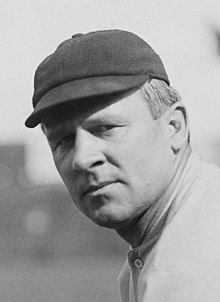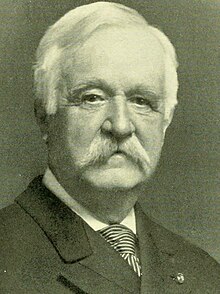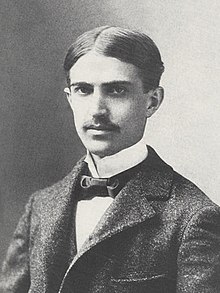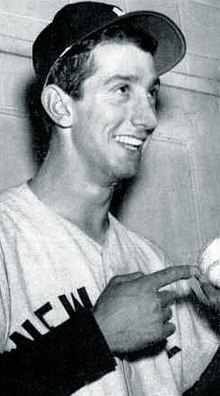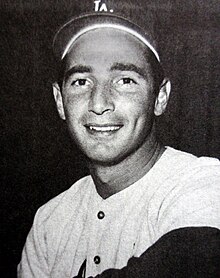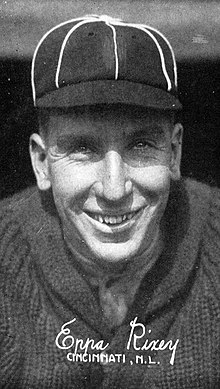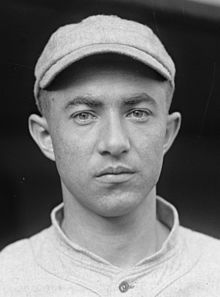Portal:Baseball
Portal maintenance status: (June 2018)
|
| Main page | Content, Categories & Topics | WikiProjects & Things you can do |
The Baseball Portal
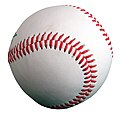
Baseball is a bat-and-ball sport played between two teams of nine players each, taking turns batting and fielding. The game occurs over the course of several plays, with each play generally beginning when a player on the fielding team, called the pitcher, throws a ball that a player on the batting team, called the batter, tries to hit with a bat. The objective of the offensive team (batting team) is to hit the ball into the field of play, away from the other team's players, allowing its players to run the bases, having them advance counter-clockwise around four bases to score what are called "runs". The objective of the defensive team (referred to as the fielding team) is to prevent batters from becoming runners, and to prevent runners advancing around the bases. A run is scored when a runner legally advances around the bases in order and touches home plate (the place where the player started as a batter).
The opposing teams switch back and forth between batting and fielding; the batting team's turn to bat is over once the fielding team records three outs. One turn batting for each team constitutes an inning. A game is usually composed of nine innings, and the team with the greater number of runs at the end of the game wins. Most games end after the ninth inning, but if scores are tied at that point, extra innings are usually played. Baseball has no game clock, though some competitions feature pace-of-play regulations such as the pitch clock to shorten game time.
Baseball evolved from older bat-and-ball games already being played in England by the mid-18th century. This game was brought by immigrants to North America, where the modern version developed. Baseball's American origins, as well as its reputation as a source of escapism during troubled points in American history such as the American Civil War and the Great Depression, have led the sport to receive the moniker of "America's Pastime"; since the late 19th century, it has been unofficially recognized as the national sport of the United States, though in modern times is considered less popular than other sports, such as American football. In addition to North America, baseball spread throughout the rest of the Americas and the Asia–Pacific in the 19th and 20th centuries, and is now considered the most popular sport in parts of Central and South America, the Caribbean, and East Asia, particularly in Japan, South Korea, and Taiwan. (Full article...)
 Featured articles - load new batch
Featured articles - load new batch
-
Image 1
John Joseph McGraw (April 7, 1873 – February 25, 1934) was an American Major League Baseball (MLB) player and manager who was for almost thirty years manager of the New York Giants. He was also the third baseman of the pennant-winning 1890s Baltimore Orioles teams, noted for their innovative, aggressive play.
McGraw was born into poverty in Truxton, New York. He found an escape from his hometown and a bad family situation through baseball, beginning a quick rise through the minor leagues that led him to the Orioles at the age of 18. Under the tutelage of manager Ned Hanlon, the Orioles of the 1890s won three National League (NL) pennants; McGraw was one of the stalwarts of the team alongside Wee Willie Keeler, Hughie Jennings, and Wilbert Robinson. The Orioles perfected the hit and run play and popularized the Baltimore chop; they also sought to win by intimidating the opposing team and the umpire. (Full article...) -
Image 2
Kenesaw Mountain Landis (/ˈkɛnɪsɔː ˈmaʊntɪn ˈlændɪs/; November 20, 1866 – November 25, 1944) was an American jurist who served as a United States federal judge from 1905 to 1922 and the first commissioner of baseball from 1920 until his death. He is remembered for his resolution of the Black Sox Scandal, in which he expelled eight members of the Chicago White Sox from organized baseball for conspiring to lose the 1919 World Series and repeatedly refused their reinstatement requests. His iron rule over baseball in the near quarter-century of his commissionership is generally credited with restoring public confidence in the game.
Landis was born in Millville, Ohio. Raised in Indiana, he became a lawyer, and then personal secretary to Walter Q. Gresham, the new United States Secretary of State, in 1893. He returned to private practice after Gresham died in office. (Full article...) -
Image 3
Morgan Gardner Bulkeley (December 26, 1837 – November 6, 1922) was an American politician of the Republican Party, businessman, and insurance executive. In 1876, he served as the first president of baseball's National League and, because of that, was inducted into the National Baseball Hall of Fame in 1937, a choice that remains controversial, since his time as a baseball executive was short.
Bulkeley was born in East Haddam, Connecticut. His father was Judge Eliphalet Adams Bulkeley, a prominent local lawyer and businessman, who became the first president of the Aetna Life Insurance Company. The family moved to Hartford, where Morgan Bulkeley was educated, before he took a job in the city of Brooklyn, New York. He served briefly in the American Civil War, where he saw no combat. When his father died in 1872, he moved back to Hartford and became a bank president and a board member of Aetna, becoming its president in 1879, a post he held the rest of his life. (Full article...) -
Image 4
Stephen Crane (November 1, 1871 – June 5, 1900) was an American poet, novelist, and short story writer. Prolific throughout his short life, he wrote notable works in the Realist tradition as well as early examples of American Naturalism and Impressionism. He is recognized by modern critics as one of the most innovative writers of his generation.
The ninth surviving child of Methodist parents, Crane began writing at the age of four and had several articles published by 16. Having little interest in university studies though he was active in a fraternity, he left Syracuse University in 1891 to work as a reporter and writer. Crane's first novel was the 1893 Bowery tale Maggie: A Girl of the Streets, generally considered by critics to be the first work of American literary Naturalism. He won international acclaim for his Civil War novel The Red Badge of Courage (1895), considered a masterpiece by critics and writers. (Full article...) -
Image 5

Hershiser pitching for the Dodgers in 1993
During the 1988 Major League Baseball season, pitcher Orel Hershiser of the Los Angeles Dodgers set the MLB record for consecutive scoreless innings pitched. Over 59 consecutive innings, opposing hitters did not score a run against Hershiser. During the streak, he averted numerous high-risk scoring situations. The streak spanned from the sixth inning of an August 30 game against the Montreal Expos to the 10th inning of a September 28 game against the San Diego Padres. The previous record of 58+2⁄3 innings was set by former Dodger pitcher Don Drysdale in 1968; as the team's radio announcer, Drysdale called Hershiser's streak as he pursued the new record. Pundits have described the streak as among the greatest records in baseball history, with one pundit ranking it among the greatest individual feats in American sports.
During the streak, the Elias Sports Bureau changed its criteria for the official consecutive scoreless innings record for starting pitchers from including fractional innings in which one or two outs had been recorded to counting only complete scoreless innings. Since the streak was active at the end of the 1988 season, it could have spanned two separate seasons. However, Hershiser yielded a run in his first inning of work in the 1989 season against the Cincinnati Reds, thus ending the streak at 59 consecutive scoreless innings pitched. The streak includes only innings pitched in the regular season, excluding eight scoreless innings Hershiser pitched to start Game 1 of the 1988 National League Championship Series on October 4 (unofficially extending his streak to 67 combined innings). Although he completed the ninth inning in each start, the streak's final game lasted 16 innings, of which he pitched only the first 10. Thus, Hershiser did not match Drysdale's record of six consecutive complete game shutouts. Like Drysdale's streak, the penultimate game of Hershiser's streak was a Dodgers–Giants game that featured a controversial umpire's ruling that saved the streak. (Full article...) -
Image 6
Earvin "Magic" Johnson Jr. (born August 14, 1959) is an American businessman and former professional basketball player. Often regarded as the greatest point guard of all time, Johnson spent his entire career with the Los Angeles Lakers in the National Basketball Association (NBA). After winning a national championship with the Michigan State Spartans in 1979, Johnson was selected first overall in the 1979 NBA draft by the Lakers, leading the team to five NBA championships during their "Showtime" era. Johnson retired abruptly in 1991 after announcing that he had contracted HIV, but returned to play in the 1992 All-Star Game, winning the All-Star MVP Award. After protests against his return from his fellow players, he retired again for four years, but returned in 1996, at age 36, to play 32 games for the Lakers before retiring for the third and final time.
Known for his extraordinary court vision, passing abilities, and leadership, Johnson was one of the most dominant players of his era. His career achievements include three NBA Most Valuable Player Awards, three NBA Finals MVPs, nine All-NBA First Team designations, and twelve All-Star games selections. He led the league in regular season assists four times, and is the NBA's all-time leader in average assists per game in both the regular season (11.19 assists per game) and the playoffs (12.35 assists per game). He also holds the records for most career playoff assists and most career playoff triple-doubles. Johnson was the co-captain of the 1992 United States men's Olympic basketball team ("The Dream Team"), which won the Olympic gold medal in Barcelona; Johnson hence became one of eight players to achieve the basketball Triple Crown. After leaving the NBA in 1991, he formed the Magic Johnson All-Stars, a barnstorming team that traveled around the world playing exhibition games. (Full article...) -
Image 7
Alfred Manuel "Billy" Martin Jr. (May 16, 1928 – December 25, 1989) was an American Major League Baseball second baseman and manager who, in addition to leading other teams, was five times the manager of the New York Yankees. First known as a scrappy infielder who made considerable contributions to the championship Yankee teams of the 1950s, he then built a reputation as a manager who would initially make bad teams good, before ultimately being fired amid dysfunction. In each of his stints with the Yankees he managed them to winning records before being fired by team owner George Steinbrenner or resigning under fire, usually amid a well-publicized scandal such as Martin's involvement in an alcohol-fueled fight.
Martin was born in a working-class section of Berkeley, California. His skill as a baseball player gave him a route out of his home town. Signed by the Pacific Coast League Oakland Oaks, Martin learned much from Casey Stengel, the man who would manage him both in Oakland and in New York, and enjoyed a close relationship with Stengel. Martin's spectacular catch of a wind-blown Jackie Robinson popup late in Game Seven of the 1952 World Series saved that series for the Yankees, and he was the hitting star of the 1953 World Series, earning the Most Valuable Player award in the Yankee victory. He missed most of two seasons, 1954 and 1955, after being drafted into the Army, and his abilities never fully returned; the Yankees traded him after a brawl at the Copacabana club in New York during the 1957 season. Martin bitterly resented being traded, and did not speak to Stengel for years, a time during which Martin completed his playing career with various teams. (Full article...) -
Image 8
Stanley Frank Musial (/ˈmjuːziəl, -ʒəl/; born Stanislaw Franciszek Musial; November 21, 1920 – January 19, 2013), nicknamed "Stan the Man", was an American baseball outfielder and first baseman. Widely considered to be one of the greatest and most consistent hitters in baseball history, Musial spent 22 seasons in Major League Baseball (MLB), playing for the St. Louis Cardinals, from 1941 to 1944 and from 1946 to 1963. He was inducted into the Baseball Hall of Fame in 1969 in his first year of eligibility.
Musial was born in Donora, Pennsylvania, where he frequently played baseball informally or in organized settings, and eventually played on the baseball team at Donora High School. Signed to a professional contract by the St. Louis Cardinals as a pitcher in 1938, Musial was converted into an outfielder and made his major league debut in 1941. Noted for his unique batting stance, he quickly established himself as a consistent and productive hitter. In his first full season, 1942, the Cardinals won the World Series. The following year, he led the NL in six different offensive categories and earned his first MVP award. He was also named to the NL All-Star squad for the first time; he appeared in every All-Star game in every subsequent season he played. Musial won his second World Series championship in 1944, then missed the 1945 season while serving in the Navy. After completing his military service, Musial returned to baseball in 1946 and resumed his consistent hitting. That year he earned his second MVP award and third World Series title. His third MVP award came in 1948, when he finished one home run short of winning baseball's Triple Crown. After struggling offensively in 1959, Musial used a personal trainer to help maintain his productivity until he decided to retire in 1963. (Full article...) -
Image 9
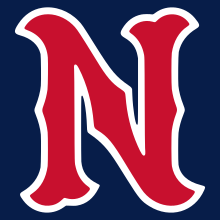
The Nashville Sounds are a Minor League Baseball team of the International League and the Triple-A affiliate of the Milwaukee Brewers. They are located in Nashville, Tennessee, and are named for the city's association with the music industry, specifically the "Nashville sound", a subgenre of country music which originated in the city in the mid-1950s. The team plays their home games at First Horizon Park, which opened in 2015 on the site of the historic Sulphur Dell ballpark. The Sounds previously played at Herschel Greer Stadium from its opening in 1978 until the end of the 2014 season. They are the oldest active professional sports franchise in Nashville.
Established as an expansion team of the Double-A Southern League in 1978, the Sounds led all of Minor League Baseball in attendance in their inaugural season and continued to draw the Southern League's largest crowds in each of their seven years as members. On the field, the team won six consecutive second-half division titles from 1979 to 1984 and won the Southern League championship twice: in 1979 as the Double-A affiliate of the Cincinnati Reds and again in 1982 as the Double-A affiliate of the New York Yankees. (Full article...) -
Image 10
Sanford Koufax (/ˈkoʊfæks/; né Braun; born December 30, 1935), nicknamed "the Left Arm of God", is an American former baseball pitcher who played 12 seasons in Major League Baseball (MLB) for the Brooklyn/Los Angeles Dodgers from 1955 to 1966. Widely regarded as one of the greatest pitchers in baseball history, Koufax was the first three-time winner of the Cy Young Award, each time winning unanimously and the only pitcher to do so when a single award was given for both the leagues; he was also named the National League Most Valuable Player in 1963. Retiring at the age of 30 due to chronic pain in his pitching elbow, Koufax was elected to the Baseball Hall of Fame in his first year of eligibility in 1972 at the age of 36, the youngest player ever elected.
Born in Brooklyn, New York, Koufax was primarily a basketball player in his youth and had pitched in only a few games before signing with the Brooklyn Dodgers at age 19. Due to the bonus rule he signed under, Koufax never pitched in the minor leagues. His lack of pitching experience caused manager Walter Alston to distrust Koufax, who saw inconsistent playing time during his first six seasons. As a result, though he often showed flashes of brilliance, Koufax struggled early on. Frustrated with the way he was being managed by the Dodgers, he almost quit after the 1960 season. After making adjustments prior to the 1961 season, Koufax quickly rose to become the most dominant pitcher in the major leagues, as well as the first major sports star on the West Coast. He was an All-Star in each of his last six seasons, leading the National League (NL) in earned run average each of his last five years, in strikeouts four times, and in wins and shutouts three times each. He was the first pitcher in the live-ball era to post an earned run average below 2.00 in three different qualifying seasons, and the first ever to record a 300-strikeout season three times. (Full article...) -
Image 11
Morris Berg (March 2, 1902 – May 29, 1972) was an American professional baseball catcher and coach in Major League Baseball who later served as a spy for the Office of Strategic Services during World War II. He played 15 seasons in the major leagues, almost entirely for four American League teams, though he was never more than an average player and was better known for being "the brainiest guy in baseball." Casey Stengel once described Berg as "the strangest man ever to play baseball."
Berg was a graduate of Princeton University and Columbia Law School, spoke several languages, and regularly read ten newspapers a day. His reputation as an intellectual was fueled by his successful appearances as a contestant on the radio quiz show Information Please, in which he answered questions about the etymology of words and names from Greek and Latin, historical events in Europe and the Far East, and ongoing international conferences. (Full article...) -
Image 12
Harmon Clayton Killebrew Jr. (/ˈkɪlɪbruː/; June 29, 1936 – May 17, 2011), nicknamed "the Killer" and "Hammerin' Harmon", was an American professional baseball first baseman, third baseman, and left fielder. He spent most of his 22-year career in Major League Baseball (MLB) with the Minnesota Twins. A prolific power hitter, Killebrew had the fifth-most home runs in major league history at the time of his retirement. He was second only to Babe Ruth in American League (AL) home runs, and was the AL career leader in home runs by a right-handed batter. Killebrew was inducted into the National Baseball Hall of Fame in 1984.
Killebrew was 5-foot-11-inch (180 cm) tall and 213 pounds (97 kg). His compact swing generated tremendous power and made him one of the most feared power hitters of the 1960s, when he hit at least 40 home runs per season eight times. In total Killebrew led the league six times in home runs and three times in RBIs, and was named to 13 All-Star teams. In 1965, he played in the World Series with the Twins, who lost to the Los Angeles Dodgers. His finest season was 1969, when he hit 49 home runs, recorded 140 RBIs and won the AL Most Valuable Player Award while helping lead the Twins to the AL West pennant. (Full article...) -
Image 13
Arthur Joseph Houtteman (August 7, 1927 – May 6, 2003) was an American right-handed pitcher in Major League Baseball who played for 12 seasons in the American League with the Detroit Tigers, Cleveland Indians and Baltimore Orioles. In 325 career games, Houtteman pitched 1,555 innings and posted a win–loss record of 87–91, with 78 complete games, 14 shutouts, and a 4.14 earned run average (ERA).
Known on the sandlot for his pitching motion, Houtteman was signed by scout Wish Egan in 1945 at 17 years of age. He was recruited by major league teams, and joined a Tigers pitching staff that had lost players to injuries and World War II. After moving between the major and minor leagues over the next few years, he was nearly killed in an automobile accident just before the 1949 season. Houtteman rebounded from his injuries and went on to win 15 games that season and made his only All-Star appearance in the following year. (Full article...) -
Image 14

Depiction of the game from The Boston Globe
On Saturday, May 1, 1920, the Brooklyn Dodgers and the Boston Braves played to a 1–1 tie in 26 innings, the most innings ever played in a single game in the history of Major League Baseball (MLB). The game was played at Braves Field in Boston before a crowd estimated at 4,000. Both Leon Cadore of Brooklyn and Joe Oeschger of Boston pitched complete games, and with 26 innings pitched, jointly hold the record for the longest pitching appearance in MLB history. Their record is considered unbreakable, as modern pitchers rarely pitch even nine innings, and newer baseball rules have made long extra-innings games a rarity.
The day of the game saw rainy weather, and it was uncertain if the game would be played, but the skies cleared enough to allow it to proceed. Brooklyn scored a run in the fifth inning, and Boston in the sixth; thereafter, the pitchers became increasingly dominant. As the game exceeded eighteen innings, the small crowd at Braves Field cheered both pitchers. The last twenty innings were scoreless, and when darkness started to fall, the umpires called a halt after the twenty-sixth inning, as baseball fields did not yet have artificial lighting. (Full article...) -
Image 15Los Angeles Angels center fielder Mike Trout hits a home run on a pitch from New York Mets pitcher Tommy Milone on May 21, 2017.
Baseball is a bat-and-ball sport played between two teams of nine players each, taking turns batting and fielding. The game occurs over the course of several plays, with each play generally beginning when a player on the fielding team, called the pitcher, throws a ball that a player on the batting team, called the batter, tries to hit with a bat. The objective of the offensive team (batting team) is to hit the ball into the field of play, away from the other team's players, allowing its players to run the bases, having them advance counter-clockwise around four bases to score what are called "runs". The objective of the defensive team (referred to as the fielding team) is to prevent batters from becoming runners, and to prevent runners advancing around the bases. A run is scored when a runner legally advances around the bases in order and touches home plate (the place where the player started as a batter).
The initial objective of the batting team is to have a player reach first base safely; this generally occurs either when the batter hits the ball and reaches first base before an opponent retrieves the ball and touches the base, or when the pitcher persists in throwing the ball out of the batter's reach. Players on the batting team who reach first base without being called "out" can attempt to advance to subsequent bases as a runner, either immediately or during teammates' turns batting. The fielding team tries to prevent runs by using the ball to get batters or runners "out", which forces them out of the field of play. The pitcher can get the batter out by throwing three pitches which result in strikes, while fielders can get the batter out by catching a batted ball before it touches the ground, and can get a runner out by tagging them with the ball while the runner is not touching a base. (Full article...)
General images - load new batch
-
Image 1Diagram of a baseball field Diamond may refer to the square area defined by the four bases or to the entire playing field. The dimensions given are for professional and professional-style games. Children often play on smaller fields. (from Baseball)
-
Image 2The typical motion of a right-handed pitcher (from Baseball rules)
-
Image 4Jackie Robinson in 1945, with the era's Kansas City Royals, a barnstorming squad associated with the Negro American League's Kansas City Monarchs (from History of baseball)
-
Image 5Pick-off attempt on runner (in red) at first base (from Baseball rules)
-
Image 6Fenway Park, home of the Boston Red Sox. The Green Monster is visible beyond the playing field on the left. (from Baseball)
-
Image 8The strike zone, which determines the outcome of most pitches, varies in vertical length depending on the batter's typical height while swinging. (from Baseball rules)
-
Image 9A well-worn baseball (from Baseball)
-
Image 10In May 2010, the Philadelphia Phillies' Roy Halladay pitched the 20th major league perfect game. That October, he pitched only the second no-hitter in MLB postseason history. (from History of baseball)
-
Image 12The strike zone determines the result of most pitches, and varies in vertical length for each batter. (from Baseball)
-
Image 13Alexander Cartwright, father of modern baseball (from History of baseball)
-
Image 14Two players on the baseball team of Tokyo, Japan's Waseda University in 1921 (from Baseball)
-
Image 15The NL champion New York Giants baseball team, 1913. Fred Merkle, sixth in line, had committed a baserunning gaffe in a crucial 1908 game that became famous as Merkle's Boner. (from History of baseball)
-
Image 16A batter follows through after swinging at a pitched ball. (from Baseball rules)
-
Image 17Cy Young—the holder of many major league career marks, including wins and innings pitched, as well as losses—in 1908. MLB's annual awards for the best pitcher in each league are named for Young. (from Baseball)
-
Image 18By the 1860s Civil War, baseball (bottom) had overtaken its fellow bat-and-ball sport cricket (top) in popularity within the United States. (from History of baseball)
-
Image 19Defensive positions on a baseball field, with abbreviations and scorekeeper's position numbers (not uniform numbers) (from Baseball)
-
Image 20Japanese-Americans spectating a World War II-era game while in an internment camp. America's ties to immigrants and to Japan have been deeply shaped by a shared baseball heritage. (from History of baseball)
-
Image 22A game from the Cantigas de Santa Maria, c. 1280, involving tossing a ball, hitting it with a stick and competing with others to catch it (from History of baseball)
-
Image 23Sadaharu Oh managing the Japan national team in the 2006 World Baseball Classic. Playing for the Central League's Yomiuri Giants (1959–80), Oh set the professional world record for home runs with 868. (from History of baseball)
-
Image 25The American Tobacco Company's line of baseball cards featured shortstop Honus Wagner of the Pittsburgh Pirates from 1909 to 1911. In 2007, the card shown here sold for $2.8 million. (from Baseball)
-
Image 26A first baseman receives a pickoff throw, as the runner dives back to first base. (from Baseball)
-
Image 27Jackie Robinson in 1945, with the era's Kansas City Royals, a barnstorming squad associated with the Negro American League's Kansas City Monarchs (from Baseball)
-
Image 29Cover of Official Base Ball Rules, 1921 edition, used by the American League and National League (from Baseball rules)
-
Image 30Sadaharu Oh managing the Japan national team in the 2006 World Baseball Classic. Playing for the Central League's Yomiuri Giants (1959–80), Oh set the professional world record for home runs. (from Baseball)
-
Image 31Baserunners generally stand a short distance away from their base between pitches, preparing themselves to either go back or steal the next base. (from Baseball rules)
-
Image 34Baseball games sometimes end in a walk-off home run, with the batting team usually gathering at home plate to celebrate the scoring of the winning run(s). (from Baseball rules)
-
Image 35Pesäpallo, a Finnish variation of baseball, was invented by Lauri "Tahko" Pihkala in the 1920s, and after that, it has changed with the times and grown in popularity. Picture of Pesäpallo match in 1958 in Jyväskylä, Finland. (from Baseball)
-
Image 36Rickey Henderson—the major leagues' all-time leader in runs and stolen bases—stealing third base in a 1988 game (from Baseball)
-
Image 381906 World Series, infielders playing "in" for the expected bunt and the possible play at the plate with the bases loaded (from Baseball rules)
-
Image 39Pitchers are generally substituted during mound visits (team gatherings at the pitcher's mound). (from Baseball rules)
-
Image 40The standard fielding positions (from Baseball rules)
-
Image 41A pitcher handing off the ball after being taken out of the game during a mound meeting. (from Baseball)
-
Image 42A runner sliding into home plate and scoring. (from Baseball)
-
Image 43An Afghan girl playing baseball in August 2002 (from Baseball)
-
Image 44A New York Yankees batter (Andruw Jones) and a Boston Red Sox catcher at Fenway Park (from Baseball)
-
Image 452013 World Baseball Classic championship match between the Dominican Republic and Puerto Rico, March 20, 2013 (from Baseball)
 Good articles - load new batch
Good articles - load new batch
-
Image 1
Richard Edward Donovan (December 7, 1927 – January 6, 1997) was an American Major League Baseball pitcher who played for the Boston Braves (1950–1952), Detroit Tigers (1954), Chicago White Sox (1955–1960), Washington Senators (1961) and Cleveland Indians (1962–1965). He batted left-handed and threw right-handed, stood 6 feet 3 inches (1.91 m) tall and weighed 190 pounds (86 kg).
A Boston native, Donovan graduated from North Quincy High School and served in the United States Navy during and after World War II. Signed by the hometown Braves, he reached the major leagues in 1950 but was used sporadically over the next several years. While pitching for the minor league Atlanta Crackers, he learned how to throw a slider, and this helped him claim a spot in the White Sox' rotation in 1955. He was an All-Star in his first major league season, winning 15 games with only nine losses. In 1956, he led the American League (AL) with a 1.155 walks plus hits per innings pitched. He led the AL with a .727 winning percentage in 1957, going 16–6, and he won 15 games for the White Sox in 1958. He pitched in the 1959 World Series against the Los Angeles Dodgers, losing Game 3 but earning the save in Game 5. Donovan struggled in 1960 and was moved to the bullpen, then got selected in the expansion draft by the Senators after the season. He had his best year with the new club in 1961, leading the AL with a 2.40 earned run average (ERA), though his won-loss record was just 10–10. Traded to the Indians for Jimmy Piersall after the season, he won 20 games his first year with Cleveland. Donovan pitched three more years for the Indians after that before getting released midway through 1965. Following his baseball career, he sold insurance and held other jobs in the Quincy, Massachusetts area before dying of cancer in 1997. (Full article...) -
Image 2
Eppa Rixey Jr. (May 3, 1891 – February 28, 1963), nicknamed "Jephtha", was an American baseball player who played 21 seasons for the Philadelphia Phillies and Cincinnati Reds in Major League Baseball from 1912 to 1933 as a left-handed pitcher. Rixey was best known as the National League's leader in career victories for a left-hander with 266 wins until Warren Spahn surpassed his total in 1959.
Rixey attended the University of Virginia where he was a star pitcher. He was discovered by umpire Cy Rigler, who convinced him to sign directly with the Phillies, bypassing minor league baseball entirely. His time with the Phillies was marked by inconsistency. He won 22 games in 1916, but also led the league in losses twice. In 1915, the Phillies played in the World Series, and Rixey lost in his only appearance. After being traded to the Reds prior to the 1921 season, he won 20 or more games in a season three times, including a league-leading 25 in 1922, and posted eight consecutive winning seasons. His skills were declining by the 1929 season, when his record was 10–13 with a 4.16 earned run average. He pitched another four seasons before retiring after the 1933 season. (Full article...) -
Image 3
James Evan Gattis (born August 18, 1986) is an American former professional baseball designated hitter and catcher. He played in Major League Baseball (MLB) for the Atlanta Braves and Houston Astros. Gattis has also earned the nickname of El Oso Blanco or The White Bear, due to his raw power capabilities when playing for the Venezuelan Professional Baseball League. While with Atlanta, he played catcher and occasionally left field.
Gattis was a premier amateur baseball player in the Dallas–Fort Worth area through high school. However, anxiety and substance abuse led him to abandon his scholarship to Texas A&M University. After wandering around the Western United States for four years, he returned to baseball, and was drafted by the Braves in 2010. (Full article...) -
Image 4Lawrence William Kennedy (May 1917 – March 4, 1995) was an American professional baseball player. A left-handed pitcher, he played two seasons in the minor leagues with the Mayfield Clothiers, Siloam Springs Travelers and Lincoln Links, and was known for going from living at Father Flanagan's Boys' Home in Boys Town, Nebraska, to playing professional baseball. He also twice served as the mayor of Boys Town, and was for a time their police commissioner as well as director of public safety. (Full article...)
-
Image 5Gordon Roger Cooper (April 1, 1930 – March 15, 2022) was an American college football player and sports coach. He played collegiately for the Denver Pioneers as an end, where he was the national receptions leader in 1950, and later was selected by the Detroit Lions in the sixth round of the 1952 NFL draft. He was drafted to serve in the United States Army prior to the 1952 NFL season and suffered an injury when he returned to the team in 1954. After a brief stint with the Montreal Alouettes in 1955, he retired from playing and began a long career as a coach, starting with his alma mater, Denver, and then with Rifle High School from 1956 to 1987, where he coached multiple sports and was athletic director. He was inducted into the University of Denver Athletic Hall of Fame in 2010. (Full article...)
-
Image 6Fenway Park in Boston, game venue
The 1948 American League tie-breaker game was a one-game extension to Major League Baseball's (MLB) 1948 regular season, played between the Cleveland Indians and Boston Red Sox to determine the winner of the American League (AL) pennant. The game was played on October 4, 1948, at Fenway Park in Boston, Massachusetts. It was necessary after both teams finished the season with identical win–loss records of 96–58. This was the first-ever one-game playoff in the AL, and the only one before 1969, when the leagues were split into divisions.
The Indians defeated the Red Sox, 8–3, as the Indians scored four runs in the fourth inning and limited the Red Sox to five hits. The Indians advanced to the 1948 World Series, where they defeated the Boston Braves, four games to two, giving them their second and most recent World Series championship. In baseball statistics, the tie-breaker counted as the 155th regular season game by both teams, with all events in the game added to regular season statistics. (Full article...) -
Image 7"Go Cubs Go", "Go, Cubs, Go" or "Go, Cubs, Go!" is a song written by Steve Goodman in 1984. At various times the Goodman version of the song has been the official Chicago Cubs team song and the official Cubs victory song, playing after every home win for the Cubs at Wrigley Field. The Goodman version has been included in both a 1994 Steve Goodman anthology album and a 2008 Cubs songs and sounds album. Following the team's 2016 World Series victory, the song peaked at number 3 on Billboard's Bubbling Under Hot 100 Singles chart. An alternate 2008 version by Manic Sewing Circle has also been released. (Full article...)
-
Image 8
Lewis Everett Scott (November 19, 1892 – November 2, 1960), nicknamed "Deacon", was an American professional baseball player. A shortstop, Scott played in Major League Baseball for 12 seasons as a member of the Boston Red Sox, New York Yankees, Washington Senators, Chicago White Sox and Cincinnati Reds, from 1914 through 1926. Scott batted and threw right-handed.
Scott served as captain of both the Red Sox and Yankees, who have become fierce rivals. He compiled a lifetime batting average of .249, hitting 20 home runs with 551 runs batted in in 1,654 games. He led American League shortstops in fielding percentage seven straight seasons (1916–22) and appeared in 1,307 consecutive games from June 20, 1916, through May 6, 1925, setting a record later broken by Lou Gehrig. As of 2022[update], it is still the third-longest streak in history. (Full article...) -
Image 9Dallas Braden in 2010
On May 9, 2010, Dallas Braden of the Oakland Athletics threw a perfect game against the Tampa Bay Rays at Oakland–Alameda County Coliseum. It was the 19th perfect game in Major League Baseball history. Braden threw 109 pitches, struck out 6 of the 27 batters he faced, and had a game score of 93.
Braden's perfect game occurred on Mother's Day, a holiday he resented due to the death of his mother from melanoma. He got drunk the night before and was still suffering from the effects of a hangover when he got to the stadium. Of the 27 batters Braden faced, the at bats that posed the greatest threat were Jason Bartlett's at bat in the first inning and Gabe Kapler's at bat in the ninth inning. Bartlett hit a hit a line drive that forced third baseman Kevin Kouzmanoff to make a jumping catch. In Kapler's at bat, Braden incorrectly believed the count was two balls and two strikes when it was actually three balls and one strike. Braden threw a pitch outside of the strike zone, and had Kapler not swung at it, he would have drawn a walk and ended the perfect game. (Full article...) -
Image 10Louis James Daukas (July 4, 1921 – December 22, 2005) was an American football center who played one season in the All-America Football Conference (AAFC) for the Brooklyn Dodgers. He played college football for the Cornell Big Red and also had a stint with the Detroit Lions of the National Football League (NFL). He additionally was a coach and became an attorney after his football career. (Full article...)
-
Image 11
E. Roy Lester (October 3, 1923 – May 3, 2020) was an American college and high school football coach. After a successful career at the high school level, he served as the head coach of the University of Maryland football team from 1969 to 1971. Lester was the school's fourth head coach in five years, and compiled a 7–25 record during his tenure. He was fired after the 1971 season when Maryland finished at the bottom of the Atlantic Coast Conference for the second consecutive year.
Lester returned to coach interscholastic football, including as head coach of Richard Montgomery High School where his teams compiled an 86–10–1 record and six undefeated seasons. His high school teams won three Maryland state championships. Lester attended West Virginia University where he was a three-sport athlete and earned letters in football, baseball, and basketball. He was inducted into the West Virginia University Sports Hall of Fame in 2008. (Full article...) -
Image 12
William Louis Raimondi (December 1, 1912 – October 18, 2010) was an American professional baseball catcher. He played in Minor League Baseball for 22 years, including 21 years in the Pacific Coast League (PCL). He played for the Oakland Oaks from 1932 to 1949, the Sacramento Solons from 1949 to 1950, and the Los Angeles Angels from 1951 to 1953. Raimondi is a member of the PCL Hall of Fame, elected in 1951.
Raimondi was born and raised in the San Francisco Bay Area. After a standout baseball career at McClymonds High School in Oakland, California, Raimondi signed with the Oaks of the PCL. He tried out with the Cincinnati Reds for the 1936 season, but an arm injury prevented him from playing in Major League Baseball (MLB). Raimondi returned to the Oaks in 1937, and declined further opportunities from MLB clubs to stay close to home. He served as the interim manager of the Oaks during the 1945 season. A year after winning the PCL championship with the 1948 Oaks under Casey Stengel, Chuck Dressen traded Raimondi to Sacramento, where he became a player-coach during the 1950 season. Signing with the Angels in 1951, Raimondi served as a backup catcher and coach through the 1953 season, when he retired. (Full article...) -
Image 13

The short right field fence at the Polo Grounds
Chinese home run, also a Chinese homer, Harlem home run, Polo home run, or Pekinese poke, is a derogatory and archaic baseball term for a hit that just barely clears the outfield fence at its closest distance to home plate. It is essentially the shortest home run possible in the ballpark in question, particularly if the park has an atypically short fence. The term was most commonly used in reference to home runs hit along the right field foul line at the Polo Grounds, home of the New York Giants, where that distance was short even by contemporary standards. When the Giants moved to San Francisco in 1958, the Los Angeles Coliseum, temporary home of the newly relocated Los Angeles Dodgers, gained the same reputation for four seasons until the team took up residence in its permanent home at Dodger Stadium in 1962. Following two seasons of use by the expansion New York Mets in the early 1960s, the Polo Grounds were demolished, and the term gradually dropped out of use.
Why these home runs were called "Chinese" is not definitely known, but it is believed to have reflected an early 20th-century perception that Chinese immigrants to the United States did the menial labor they were consigned to with a bare minimum of adequacy, and were content with minimal reward for it. A Tad Dorgan cartoon has been proposed as the likely origin, but that has not been proven; the earliest known usages are in a 1927 newspaper account of a Pittsburgh Pirates–Philadelphia Phillies major-league game, and in a 1919 newspaper account of a Los Angeles Angels–Sacramento Senators minor-league game. In the 1950s, an extended take on the term in the New York Daily News led the city's Chinese-American community to ask sportswriters not to use it. This perception of ethnic insensitivity has further contributed to its disuse. (Full article...) -
Image 14
Jamey Alan Wright (born December 24, 1974) is an American former professional baseball pitcher. He played for 10 different teams in Major League Baseball (MLB): the Colorado Rockies, Milwaukee Brewers, St. Louis Cardinals, Kansas City Royals, San Francisco Giants, Texas Rangers, Cleveland Indians, Seattle Mariners, Los Angeles Dodgers, and Tampa Bay Rays. Wright batted and threw right-handed.
An Oklahoma City native, Wright was a first round draft pick of the Rockies in 1993. He reached the majors with them in 1996 and was part of their starting rotation through the 1999 season. Traded to Milwaukee before the 2000 season, he became the Brewers' Opening Day starter in 2001, winning a career-high 11 games. After being traded to St. Louis during the 2002 season, he spent most of 2003 in the minor leagues, then pitched for the Rockies again in 2004 and 2005. He was named the fifth starter for the Giants and the Rangers in 2006 and 2007, respectively, but both times he was removed from the rotation during the year. After the 2007 season, he served almost exclusively as a reliever. (Full article...) -
Image 15
John Frederick Maulbetsch (June 20, 1890 – September 14, 1950) was an All-American football halfback at Adrian College in 1911 and for the University of Michigan Wolverines from 1914 to 1916. He is also a member of the College Football Hall of Fame.
After playing with an independent football team in Ann Arbor and at Adrian College, Maulbetsch became one of the most famous American football players in 1914 while playing for the University of Michigan. Maulbetsch became known as the "Human Bullet" because of his unusual low, line-plunging style of play, and was also known as the "Featherweight Fullback" because of his light weight and small size. After his performance against Harvard in 1914, in which some reports indicated he gained more than 300 yards, eastern writers, including Damon Runyon, wrote articles touting Maulbetsch. Maulbetsch was also selected by Walter Camp to his All-American team. (Full article...)
Did you know (auto-generated) - load new batch

- ... that Helene Hathaway Britton, the first woman to own a Major League Baseball team, was unsuccessfully pressured by other club owners to sell the team?
- ... that in 1920, Elmer Smith hit the first grand slam in World Series history?
- ... that Major League Baseball pitcher Charlie Gray was billed as his team's pitcher "of six fingers and six toed fame" and called "a freak" by the Sporting Life?
- ... that baseball player Shane Rawley has published a novel?
- ... that the only run scored by John Gamble was a game-winner?
- ... that Drew Golz, who was Baseball Academic All-American of the Year and Soccer Academic All-American of the Year, became the first male student athlete to be named Academic All-American of the year for two sports at the same time?
- ... that Jenny Cavnar is the first female primary play-by-play announcer in Major League Baseball history?
- ... that Milt Wilcox, winning pitcher of Game 3 of the 1984 World Series, credited "throwing bowling balls" with rescuing his Major League Baseball career?
Quotes
| The two most important things in life: good friends and a strong bullpen. |
 Featured lists - load new batch
Featured lists - load new batch
-
Image 1

Justin Upton, the first overall selection in 2005, was named to the 2009 All-Star Team.
The Arizona Diamondbacks are a Major League Baseball franchise based in Phoenix, Arizona. The Diamondbacks compete in the National League West division. Officially known as the "First-Year Player Draft", the Rule 4 Draft is Major League Baseball's primary mechanism for assigning amateur baseball players from high schools, colleges, and other amateur baseball clubs to its teams. The draft order is determined based on the previous season's standings, with the team possessing the worst record receiving the first pick. In addition, teams which lost free agents in the previous off-season may be awarded compensatory or supplementary picks. Since the franchise first participated in the draft in 1996, the Diamondbacks have selected 28 players in the first round. The First-Year Player Draft is unrelated to the 1997 expansion draft in which the Diamondbacks filled their roster.
Of the 28 players picked in the first round by the Diamondbacks, 15 have been pitchers, the most of any position; 11 of these have been right-handed, while 4 have been left-handed. Five players taken in the first round have been shortstops; additionally, two players have been selected at each of first base, third base, catcher, and the outfield. No second baseman has been selected in the first round by the Diamondbacks. The Diamondbacks have drafted 16 players out of college, and 10 out of high school. Arizona has drafted seven players out of high schools or colleges in the state of California, with two being taken from each of Florida, Georgia, and their home state of Arizona. (Full article...) -
Image 2
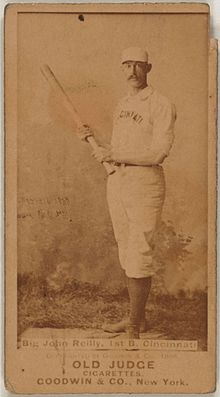
In baseball, completing the cycle is the accomplishment of hitting a single, a double, a triple, and a home run in the same game. In terms of frequency, the cycle is roughly as common as a no-hitter; Baseball Digest calls it "one of the rarest feats in baseball". Collecting the hits in the listed order is known as a "natural cycle".
The cycle itself is semi-rare in Major League Baseball (MLB), having occurred a total of 348 times, starting with Curry Foley in 1882, through Weston Wilson on August 15, 2024. A natural cycle has been completed 14 times in modern MLB history, most recently by Gary Matthews Jr. of the Texas Rangers in 2006. (Full article...) -
Image 3
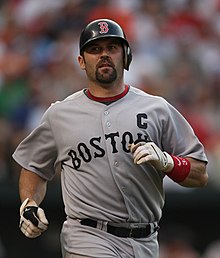
Jason Varitek, who has caught a record four no-hitters, was a selected by the American Baseball Coaches Association, Baseball America, and Collegiate Baseball.
An All-American team is an honorary sports team composed of the best amateur players of a specific season for each position—who in turn are given the honorific "All-America" and typically referred to as "All-American athletes", or simply "All-Americans". Although the honorees generally do not compete as a unit, the term is used in United States team sports to refer to players who are selected by members of the national media. Walter Camp selected the first All-America team in the early days of American football in 1889. In 1950, the American Baseball Coaches Association (ABCA) selected its first All-American baseball team. It has since chosen All-American teams and a player of the year for each division (National Collegiate Athletic Association (NCAA) Division I, Division II, Division III, National Association of Intercollegiate Athletics, junior college and high school). Collegiate Baseball selects All-American, Freshman All-American and High School All-American teams. Baseball America selects pre-season and post-season All-American teams and College Player of the Year honorees.
Various organizations selected All-American lists of the best players for the 1992 NCAA Division I college baseball season. The ABCA, the magazine Baseball America, and Collegiate Baseball were the NCAA-sanctioned selectors. This list only includes players selected to the post-season All-American first team for each selector. However, many All-American selections choose second, third, etc. teams from the remaining eligible candidates. (Full article...) -
Image 4

Brooks Robinson won 16 Gold Gloves, leading all third basemen, and is tied for the second-highest win total in the history of the award.
The Gold Glove Award is the award given annually to the Major League Baseball players judged to have exhibited superior individual fielding performances at each fielding position in both the National League (NL) and the American League (AL), as voted by the managers and coaches in each league. Managers are not permitted to vote for their own players. Eighteen Gold Gloves are awarded each year (with the exception of 1957, 1985, 2007 and 2018), one at each of the nine positions in each league. In 1957, the baseball glove manufacturer Rawlings created the Gold Glove Award to commemorate the best fielding performance at each position. The award was created from a glove made from gold lamé-tanned leather and affixed to a walnut base. Initially, only one Gold Glove per position was awarded to the top fielder at each position in the entire league; however, separate awards were given for the National and American Leagues beginning in 1958.
Brooks Robinson won 16 Gold Gloves with the Baltimore Orioles, leading both the American League and all third basemen in awards won. Mike Schmidt is tied with Nolan Arenado for second in wins at third base; Schmidt won 10 with the Philadelphia Phillies and is tied for National League third basemen in Gold Gloves. Arenado also has 10, 8 with the Rockies and 2 with the Cardinals. Scott Rolen owns the fourth-highest total, winning eight awards. Rolen won with the Phillies, the St. Louis Cardinals, and the Cincinnati Reds. Six-time winners at third base are Buddy Bell, Eric Chavez, and Robin Ventura. Adrián Beltré, Ken Boyer, Matt Chapman, Doug Rader, and Ron Santo have each won five Gold Gloves at third base, and four-time winners include Gary Gaetti and Matt Williams. Hall of Famers who have won a Gold Glove at the position include Robinson, Rolen, Schmidt, Santo, Wade Boggs, and George Brett. (Full article...) -
Image 5

Todd Worrell (1982) is the only Cardinals first-round draft pick to win the Rookie of the Year Award.
The St. Louis Cardinals are a Major League Baseball (MLB) franchise based in St. Louis, Missouri. They play in the National League Central division. Since the institution of MLB's Rule 4 Draft, the Cardinals have selected 77 players in the first round. Officially known as the "First-Year Player Draft", the Rule 4 Draft is MLB's primary mechanism for assigning amateur baseball players from high schools, colleges, and other amateur baseball clubs to its teams. The draft order is determined based on the previous season's standings, with the team possessing the worst record receiving the first pick. In addition, teams which lost free agents in the previous off-season may be awarded compensatory or supplementary picks.
Of the 77 players picked in the first round by St. Louis, 39 have been pitchers, the most of any position; 30 of them were right-handed, while nine were left-handed. Eight outfielders, ten third basemen, six shortstops, six first basemen, five catchers, and two second basemen were taken as well. The team also drafted one player, Leron Lee (1966), who played as an infielder. 16 of the players came from high schools or universities in the state of California, and Texas and Arizona follow with seven and six players. The Cardinals have not drafted any players from their home state of Missouri. (Full article...) -
Image 6
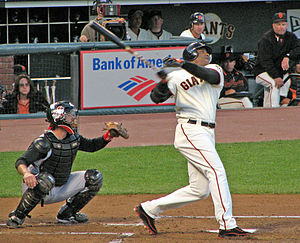
Barry Bonds, the all-time career home run leader in Major League Baseball, led the league in home runs twice including in 2001 when he set the record single-season mark
In baseball, a home run is scored when the ball is hit so far that the batter is able to circle all the bases ending at home plate, scoring himself plus any runners already on base, with no errors by the defensive team on the play. An automatic home run is achieved by hitting the ball on the fly over the outfield fence in fair territory. More rarely, an inside-the-park home run occurs when the hitter reaches home plate while the baseball remains in play on the field. In Major League Baseball (MLB), a player in each league[L] wins the home run title each season by hitting the most home runs that year. Only home runs hit in a particular league count towards that league's seasonal lead. Mark McGwire, for example, hit 58 home runs in 1997, more than any other player that year. However, McGwire was traded from the American League's (AL) Oakland Athletics to the National League's (NL) St. Louis Cardinals midway through the season and his individual AL and NL home run totals (34 and 24, respectively) did not qualify to lead either league.
The first home run champion in the National League was George Hall. In the league's inaugural 1876 season, Hall hit five home runs for the short-lived National League Philadelphia Athletics. In 1901, the American League was established and Hall of Fame second baseman Nap Lajoie led it with 14 home runs for the American League Philadelphia Athletics. Over the course of his 22-season career, Babe Ruth led the American League in home runs twelve times. Mike Schmidt and Ralph Kiner have the second and third most home run titles respectively, Schmidt with eight and Kiner with seven, all won in the National League. Kiner's seven consecutive titles from 1946 to 1952 are also the most consecutive home run titles by any player. (Full article...) -
Image 7

Tim Lincecum (2006) won two Cy Young Awards with the Giants.
The San Francisco Giants are a Major League Baseball (MLB) franchise based in San Francisco, California. They play in the National League West division. Officially known as the "First-Year Player Draft", the Rule 4 Draft is MLB's primary mechanism for assigning players from high schools, colleges, and other amateur clubs to its franchises. The draft order is determined based on the previous season's standings, with the team possessing the worst record receiving the first pick. In addition, teams which lost free agents in the previous off-season may be awarded compensatory or supplementary picks. Since the establishment of the draft in 1965, the Giants have selected 70 players in the first round.
Of those 70 players, 32 have been pitchers, the most of any position; 23 of these were right-handed, while 9 were left-handed. The Giants have also selected thirteen outfielders, seven shortstops, seven catchers, four third basemen, and three players each at first and second base. One player, 2010 selection Gary Brown, was drafted as a center fielder. The franchise has drafted eight players from colleges or high schools in their home state of California, more than any other. The Giants have never held the first-overall pick, but they did have the second pick in 1985, with which they drafted Will Clark. (Full article...) -
Image 8
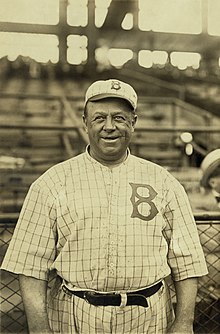
In baseball, a hit is credited to a batter when he reaches first base – or any subsequent base – safely after hitting a fair ball, without the benefit of an error or a fielder's choice. One hundred nineteen different players have recorded at least six hits in a single nine-inning Major League Baseball game. Five players have accomplished the feat more than once in their career; no player has ever recorded more than seven hits in a nine-inning game. Davy Force was the first player to collect six hits in a single game, doing so for the Philadelphia Athletics against the Chicago White Stockings on June 27, 1876.
These games have resulted in other single-game MLB records being set in connection with the prodigious offensive performance. Shawn Green, for example, established a new major league record with 19 total bases and finished with a total of five extra-base hits, tying a National League record that was also achieved by Larry Twitchell during the latter's six-hit game. Four of Green's six hits were home runs, equaling the record for most home runs in one game. Jim Bottomley, Walker Cooper, Anthony Rendon, and Wilbert Robinson hit 10 or more runs batted in (RBI) to complement their six hits. Robinson proceeded to collect a seventh hit and an eleventh RBI to set single-game records in both categories. Although his record of 11 RBIs has since been broken, Robinson's seven hits in a nine-inning game has been matched only by Rennie Stennett. (Full article...) -
Image 9
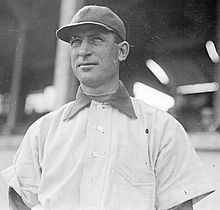
Fred Clarke, the winningest manager in Pirates history; he led the team to 1,422 victories along with a World Series title and four National League pennants.
The Pittsburgh Pirates are a Major League Baseball (MLB) franchise based in Pittsburgh, Pennsylvania. They play in the National League Central division. The team began play in 1882 as the Alleghenies (alternatively spelled "Alleghenys") in the American Association. The franchise moved to the National League after owner William Nimick became upset over a contract dispute, thus beginning the modern day franchise. The team currently plays home games at PNC Park which they moved into in 2001. Prior to PNC Park, the Pirates played games at Three Rivers Stadium and Forbes Field, among other stadiums.
There have been 46 managers for the Pittsburgh Pirates franchise. The Pirates' first manager upon joining the National League was Horace Phillips, who had coached the team before their move to the National League. In 1900, Fred Clarke began his tenure with the franchise. Clarke's 1422 victories and 969 losses lead all managers of the Pirates in their respective categories, Clarke also had the longest tenure as manager in his 16 years in the position. Clarke managed the franchise to its first World Series victory, a feat that would also be accomplished by Bill McKechnie, Danny Murtaugh, and Chuck Tanner. Thirteen Pirates managers have been player-managers—those who take on simultaneous roles as a player and manager. McKechnie, Connie Mack, and Ned Hanlon were inducted into the National Baseball Hall of Fame and Museum as managers. Five Pirates managers were inducted into the Hall of Fame for their performance as players. Billy Meyer's number 1, Pie Traynor's number 20, Honus Wagner's number 33, and Murtaugh's number 40 have been retired by the franchise. Hired before the 2020 season, the Pirates' current manager is Derek Shelton. (Full article...) -
Image 10
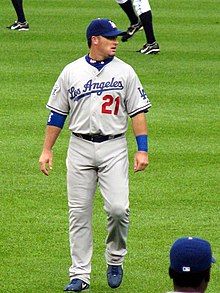
Mark Sweeney, the career pinch hit RBI recordholder, was named to the All-America Team in 1991 by both the American Baseball Coaches Association and Collegiate Baseball.
An All-American team is an honorary sports team composed of the best amateur players of a specific season for each position—who in turn are given the honorific "All-America" and typically referred to as "All-American athletes", or simply "All-Americans". Although the honorees generally do not compete as a unit, the term is used in U.S. team sports to refer to players who are selected by members of the national media. Walter Camp selected the first All-America team in the early days of American football in 1889. In 1950, the American Baseball Coaches Association (ABCA) selected its first All-American baseball team. It has since chosen All-American teams and a player of the year for each division (National Collegiate Athletic Association (NCAA) Division I, Division II, Division III, National Association of Intercollegiate Athletics, junior college and high school). In 1991, Collegiate Baseball began selecting college All-American, Freshman All-American, and High School All-American teams. Baseball America has selected – since 1981 – pre-season and post-season All-American teams and College Player of the Year honorees.
Various organizations selected All-American lists of the best players for the 1991 NCAA Division I college baseball season. The ABCA, the magazine Baseball America, and Collegiate Baseball were the NCAA-sanctioned selectors. This list only includes players selected to the post-season All-American first team for each selector. However, many All-American selections choose second, third, etc. teams from the remaining eligible candidates. (Full article...) -
Image 11
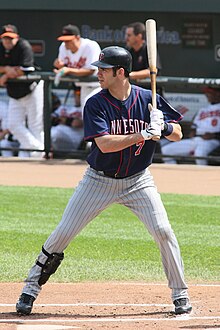
Joe Mauer, the Twins' first-overall selection in the 2001 draft, won an MVP, two Gold Gloves, three Silver Sluggers, and three batting titles.
The Minnesota Twins are a Major League Baseball (MLB) franchise based in Minneapolis, Minnesota. They play in the American League Central division. Since the institution of MLB's Rule 4 Draft, the Twins have selected 70 players in the first round. Officially known as the "First-Year Player Draft", the Rule 4 Draft is MLB's primary mechanism for assigning players from high schools, colleges, and other amateur clubs to its franchises. The draft order is determined based on the previous season's standings, with the team possessing the worst record receiving the first pick. In addition, teams which lost free agents in the previous off-season may be awarded compensatory or supplementary picks.
Of the 70 players picked in the first round by Minnesota, 30 have been pitchers, the most of any position; 22 of these were right-handed, while 8 were left-handed. Twelve outfielders were selected, while twelve shortstops, seven third basemen, four catchers, four first basemen and one player at second base were taken as well. Thirteen of the players came from high schools or universities in the state of California, and Florida follows with nine players. The Twins have drafted six players from Arizona, including five players from Arizona State University. (Full article...) -
Image 12

Todd Helton is the only first baseman to win four Silver Slugger Awards consecutively. He was the first of three players to win the award four times.
The Silver Slugger Award is awarded annually to the best offensive player at each position in both the American League (AL) and the National League (NL), as determined by the coaches and managers of Major League Baseball (MLB). These voters consider several offensive categories in selecting the winners, including batting average, slugging percentage, and on-base percentage, in addition to "coaches' and managers' general impressions of a player's overall offensive value". Managers and coaches are not permitted to vote for players on their own team. The Silver Slugger was first awarded in 1980 and is given by Hillerich & Bradsby, the manufacturer of Louisville Slugger bats. The award is a bat-shaped trophy, 3 feet (91 cm) tall, engraved with the names of each of the winners from the league and plated with sterling silver.
Among first basemen, Paul Goldschmidt has won the most Silver Sluggers, with five. Goldschmidt won the award in 2013, 2015, 2017, 2018 (Arizona Diamondbacks) and 2022 (St. Louis Cardinals). Tied for second are Todd Helton (Colorado Rockies; 2000–2003) and Albert Pujols (St. Louis Cardinals; 2004, 2008–2010) with four. In the American League, six players have won the award three times: José Abreu (Chicago White Sox; 2014, 2018, 2020), Miguel Cabrera (Detroit Tigers; 2010, 2015, 2016) Cecil Cooper (Milwaukee Brewers;[a] 1980–1982); Carlos Delgado (Toronto Blue Jays; 1999–2000, 2003), Don Mattingly (New York Yankees; 1985–1987); and Mark Teixeira (Texas Rangers, 2004–2005; New York Yankees, 2009). In the National League, two players have won the award three times: Jeff Bagwell (Houston Astros[b]; 1994, 1997, 1999); and Freddie Freeman (Atlanta Braves; 2019–2021). Mark McGwire and Eddie Murray each won a combined three Silver Slugger Awards across both leagues. McGwire won two American League Silver Sluggers for the Oakland Athletics in 1992 and 1996, and the National League Silver Slugger for the St. Louis Cardinals in 1998. Murray won two American League Silver Sluggers for the Baltimore Orioles in 1983 and 1984, and the National League Silver Slugger for the Los Angeles Dodgers in 1990. One player has won the award while playing for two different teams during his winning season. Fred McGriff was traded by the San Diego Padres to the Atlanta Braves during the 1993 season; he won the Silver Slugger Award with a .291 batting average and 37 home runs between the two teams. One father-son combination has won the award: Cecil Fielder won the American League Silver Slugger with the Detroit Tigers in 1990 and 1991, and his son Prince Fielder won the National League award with the Milwaukee Brewers in 2007 and 2011, and the American League award with the Tigers in 2012. Vladimir Guerrero Jr. and Bryce Harper are the most recent winners. Harper won his fourth overall Silver Slugger, first as a first baseman after two previous wins as an outfielder and one as a designated hitter. (Full article...) -
Image 13
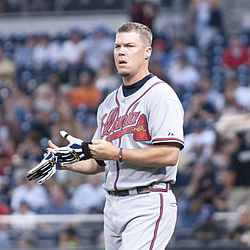
Chipper Jones won the National League MVP Award in 1999, four years after winning a World Series ring.
The Atlanta Braves are a Major League Baseball (MLB) franchise based in Atlanta, Georgia. They play in the National League East division. Officially known as the "First-Year Player Draft", the Rule 4 Draft is MLB's primary mechanism for assigning players from high schools, colleges, and other amateur clubs to its franchises. The draft order is determined based on the previous season's standings, with the team possessing the worst record receiving the first pick. In addition, teams which lost free agents in the previous off-season may be awarded compensatory or supplementary picks. Since the establishment of the draft in 1965, the Braves have selected 56 players in the first round.
Of those 56 players, 27 have been pitchers, the most of any position; 15 of these were right-handed, while 12 were left-handed. The Braves have also selected eight outfielders, seven shortstops, five catchers, four third basemen, three first basemen, and two second basemen in the initial round of the draft. The franchise has drafted nine players from colleges or high schools in the state of Florida, more than any other state. Eight more selections have come from their home state of Georgia. Two selections have come from outside the 50 United States: Luis Atilano (2003) is from the Commonwealth of Puerto Rico, and Scott Thorman (2000) is from Ontario, Canada. (Full article...) -
Image 14

In 2019, Mike Trout signed a 12-year, $426 million contract with the Angels, the richest contract in the history of North American sports at the time.
Major League Baseball (MLB) does not have a hard salary cap, instead employing a luxury tax which applies to teams whose total payroll exceeds certain set thresholds for a given season. Free agency did not exist in MLB prior to the end of the reserve clause in the 1970s, allowing owners before that time to wholly dictate the terms of player negotiations and resulting in significantly lower salaries.
Babe Ruth, widely regarded as one of the greatest baseball players ever, earned an estimated $856,850 ($19,515,718 inflation-adjusted from 1934 dollars) over his entire playing career. When asked whether he thought he deserved to earn $80,000 a year ($1,459,124 inflation-adjusted), while the president, Herbert Hoover, had a $75,000 salary, Ruth famously remarked, "What the hell has Hoover got to do with it? Besides, I had a better year than he did." (Full article...) -
Image 15
Wade Boggs has won the most Silver Slugger Awards among third basemen.
The Silver Slugger Award is awarded annually to the best offensive player at each position in both the American League (AL) and the National League (NL), as determined by the coaches and managers of Major League Baseball (MLB). These voters consider several offensive categories in selecting the winners, including batting average, slugging percentage, and on-base percentage, in addition to "coaches' and managers' general impressions of a player's overall offensive value". Managers and coaches are not permitted to vote for players on their own team. The Silver Slugger was first awarded in 1980 and is given by Hillerich & Bradsby, the manufacturer of Louisville Slugger bats. The award is a bat-shaped trophy, 3 feet (91 cm) tall, engraved with the names of each of the winners from the league and plated with sterling silver.
Among third basemen, Wade Boggs has won the most Silver Slugger Awards, winning eight times with the rival Boston Red Sox (six) and New York Yankees (two). In the National League, Mike Schmidt leads with six wins; Schmidt won the first five National League Silver Slugger Awards at third base from 1980, when he led the Philadelphia Phillies to the World Series, until 1984 when his streak was broken by Tim Wallach. Nolan Arenado collected four National League Silver Sluggers at third base with the Colorado Rockies from 2015 to 2018, and a fifth with the St. Louis Cardinals in 2022. José Ramírez also collected five Silver Sluggers at third baseman, all with the Cleveland Indians/Guardians franchise (2017–2018, 2020, 2022, 2024). Adrián Beltré and Matt Williams each won four Silver Slugger Awards; Beltre won one with the National League's Los Angeles Dodgers (2004) and three with the American League's Boston Red Sox (2010) and Texas Rangers (2011; 2014), and Williams won three National League awards with the San Francisco Giants (1990; 1993–1994) and one American League award with the Cleveland Indians (1997). Yankees third baseman Alex Rodriguez has won three American League Silver Sluggers at the position, and has ten wins in his career as he accumulated seven wins at shortstop with the Seattle Mariners and Texas Rangers. Miguel Cabrera won three Silver Slugger Awards at third base with the National League's Florida Marlins (2006) and American League's Detroit Tigers (2012–2013), to go along with three first base Silver Slugger Awards with the Tigers. In the National League, Vinny Castilla won three awards in four years for the Colorado Rockies (1995, 1997–1998). José Ramírez and Manny Machado are the most recent winners. (Full article...)
More did you know
- ... that the San Francisco Giants drafted Brock Bond when they meant to draft Casey Bond?
- ... that Eddie Gillette led the Wisconsin Badgers football team to an undefeated season and in baseball "beat some of the best pitchers in the 'Three-Eye League'"?
- ... that the 2005 book Baseball Before We Knew It brought new evidence of the origins of baseball into play?
- ... that in baseball, no Gold Glove Award-winning catcher posted an errorless season until Charles Johnson and Mike Matheny accomplished the feat twice in six years?
- ... that Bob "Horse" Reynolds founded the Los Angeles Angels baseball team and was inducted into the College Football Hall of Fame within a year?
- ... that Red Snapp was considered the "king of the minor leagues"?
Sports portals
Selected picture

| Credit: Paul Thompson |
Christopher "Christy" Mathewson (August 12, 1880 – October 7, 1925), nicknamed "Big Six", "The Christian Gentleman", or "Matty", was an American Major League Baseball right-handed pitcher. He played his entire career in what is known as the dead-ball era. In 1936, Mathewson was elected into the Baseball Hall of Fame as one of its "first five" inaugural members.
Associated Wikimedia
The following Wikimedia Foundation sister projects provide more on this subject:
-
Commons
Free media repository -
Wikibooks
Free textbooks and manuals -
Wikidata
Free knowledge base -
Wikinews
Free-content news -
Wikiquote
Collection of quotations -
Wikisource
Free-content library -
Wikiversity
Free learning tools -
Wiktionary
Dictionary and thesaurus
More portals
- Portals with triaged subpages from June 2018
- All portals with triaged subpages
- Portals with no named maintainer
- Automated article-slideshow portals with 51–100 articles in article list
- Automated article-slideshow portals with 501–1000 articles in article list
- Random portal component with 41–50 available subpages
- Automated article-slideshow portals with 201–500 articles in article list
- Random portal component with 11–15 available subpages
- Random portal component with 21–25 available image subpages



